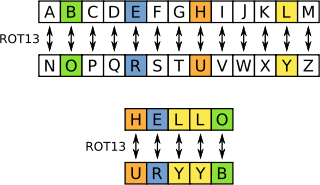
"ROT13 ("rotate by 13 places", sometimes hyphenated ROT-13) is a simple letter substitution cipher that replaces a letter with the letter 13 letters after it in the alphabet. ROT13 is a special case of the Caesar cipher, developed in ancient Rome." -- Wikipedia
In this post I will share the different ways to encode a string using ROT13 in Python, or better say in how mane ways you can do so in Python. We will show three ways to perform ROT13.
1. First Approach
import string
def rot13(text):
if isinstance(text, str):
rot13 = string.maketrans("ABCDEFGHIJKLMabcdefghijklmNOPQRSTUVWXYZnopqrstuvwxyz",
"NOPQRSTUVWXYZnopqrstuvwxyzABCDEFGHIJKLMabcdefghijklm")
return string.translate(text, rot13)
else:
raise ValueError("The parameter must be a string.")
2. Second Approach
But the problem with the above solution is that maketrans was removed in Python3. Instead we can use bytes.maketrans() for the purpose, so in order to obtain a more generalised solution we can do it as follows :-
import string
import sys
def rot13(text):
if isinstance(text, str):
if sys.version[0] == "2":
rot13_data = string.maketrans("ABCDEFGHIJKLMabcdefghijklmNOPQRSTUVWXYZnopqrstuvwxyz",
"NOPQRSTUVWXYZnopqrstuvwxyzABCDEFGHIJKLMabcdefghijklm")
return string.translate(text, rot13_data)
elif sys.version[0] == "3":
rot13_data = bytes.maketrans(b"ABCDEFGHIJKLMabcdefghijklmNOPQRSTUVWXYZnopqrstuvwxyz",
b"NOPQRSTUVWXYZnopqrstuvwxyzABCDEFGHIJKLMabcdefghijklm")
return text.translate(rot13_data)
else:
raise ValueError("The parameter must be a string.")
You can simple send your rot13 cipher/plaintext and it will encode or decode accordingly.
3. Third Approach
Another better technique is to use codecs module and use the in built rot_13 encoding scheme which is the same. Also its more preferable.
import codecs
cipher = codecs.encode("Natsu Dragneel", "rot_13")
print(cipher)
plain = codecs.decode(cipher, "rot_13")
print(plain)






0 comments :
Post a Comment